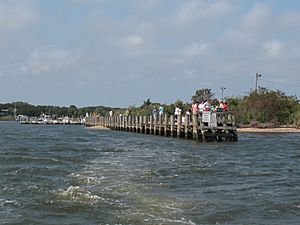Swan River (New York) facts for kids
The Swan River is a cool, clean, and free-flowing stream located in Suffolk County, New York on Long Island. It starts in the northern part of the area, flows into Swan Lake, and then continues south out of the lake. Finally, it reaches Patchogue Bay, which connects to the larger Great South Bay. Long ago, the river's beginning was much further north, near Medford, New York.
This river is usually less than 15 feet wide and has a sandy bottom. Much of it flows through natural forested wetlands, which are like swampy forests. However, some areas near the river have been developed with homes, roads, and even a sand mining operation.
Below a road called Montauk Highway, the river becomes tidal. This means its water level changes with the ocean's tides. In this tidal part, you'll find undeveloped marshland and a few boat docks. The Swan River is home to many fish and other wildlife. It has about one and a half miles of tidal water and about two and a half miles of freshwater, stretching from Swan Lake all the way to its source.
The Swan River is special because it's one of the few natural, spring-fed streams on Long Island that is still mostly untouched. Above Swan Lake, the river is a great place for brook trout to lay their eggs and raise their young. It's one of only about six places on Long Island where these wild trout still live.
Besides native fish, you can also find sea-run brown trout in the tidal part of the river. These fish come from the ocean to spawn (lay eggs) in the fall, usually from September to November. Many people enjoy fishing for these trout in the Swan River, making it an important spot for local fishing. However, there aren't any official public places to access the river for fishing or other activities. While there's lots of wildlife, there aren't any unusually large groups of specific animals known to live here.
A few small boat docks, called marinas, and untouched wild areas are found along the river's almost 2-mile path. You'll also see homes built along the river's edge.
River History
Since the 1600s, the town of Patchogue, where the Swan River flows, has been an important center for activities related to the sea. The area was first settled by Native Americans. Later, in the late 1600s, English colonists came from New England and found the bay a great place to harvest shellfish like clams and oysters, and also finfish.
Some important families who worked on the bay included the Duffys, Flints, and Weekses. They bought land near the creeks to dock their boats. They built small shacks, called shucking houses, where they would open shellfish. One of these old shucking houses still stands on Avery Avenue today. Many of their homes, especially in East Patchogue along Swan River Creek on Conklin Avenue, remind us of this rich history.
In the 2000s, fewer people work as "baymen" – people who make a living from the bay's waters – on the Swan River, in Patchogue, or in the Great South Bay.


